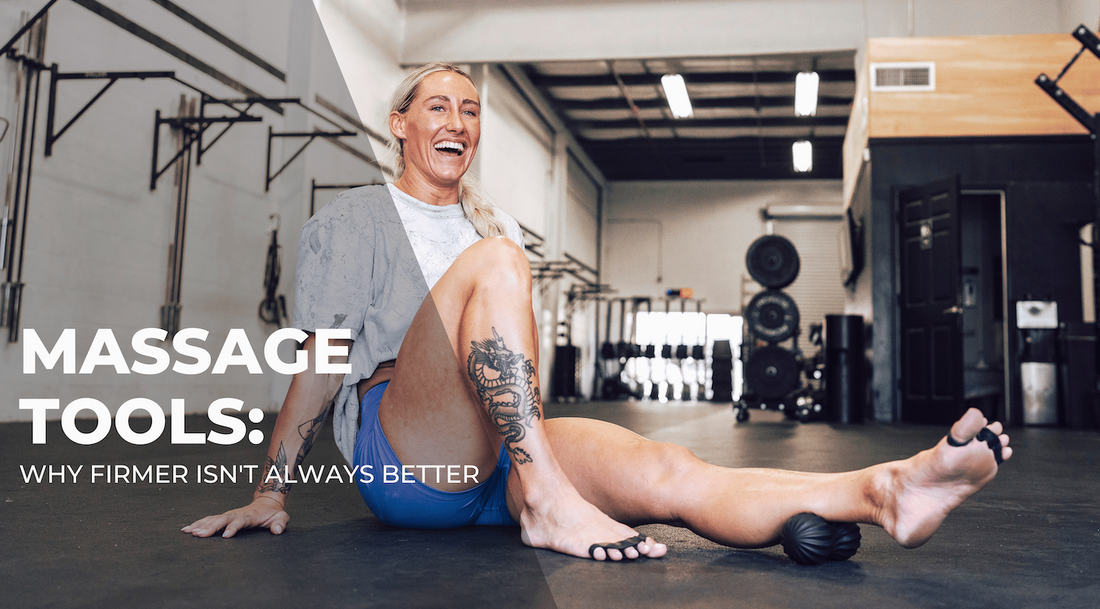
Massage tools: Why firmer isn’t always better

Have you ever laid on a massage ball only to feel it collapse under the pressure of your body? While a super-soft massage tool isn’t ideal for rolling out stiff muscles and fascia, a mini bowling ball isn’t what you want, either. Learn why firmer isn’t always better when doing fascial release!
After a tough workout that’s left you feeling tight and achy, nothing feels better than sticking a massage ball under the sore spots and wincing while you roll away the discomfort (and not in a bad way). For anyone that’s experienced DOMS before, you know first-hand that it’s not always enjoyable—and you likely also know that rolling and release techniques will probably be your best friend. But how many people fall into the camp of “the firmer the tool, the better it is to relieve my tight muscles”?
If you’ve passed on massage tools because they have a bit of give, we have news for you—they might actually be more effective than their no-give counterparts. If this comes as a surprise, you’re in the right place! We’re looking at why an ultra-firm massage ball might not be the best option for your recovery.
How do manual massage tools work?
For anyone big into fitness, manual massage tools are a must. Apart from stretching and recovery techniques (cryotherapy, hydrotherapy, sauna, etc.), they’re some of the best tools to facilitate and accelerate recovery to reduce muscle pain and inflammation.
Generally speaking, these tools are a form of myofascial release—a technique that involves the application of sustained pressure to a specific area to release tension and tightness in the muscles and surrounding fascial tissue. Healthy fascial tissue is elastic and malleable, but when it becomes tight, we experience movement restriction, pain, and discomfort. As a result, you can develop compensatory patterns for the tightness, which can exacerbate the existing issue and create a ripple effect, leading to pain elsewhere in the body.
Although MFR is generally used to treat myofascial pain syndrome, it can be effective for anyone dealing with muscle tightness. Using myofascial therapy helps to alleviate tightness in the muscles by stretching and applying continuous pressure on sore spots and nearby fascia, which can result in:
- Relaxation
- Reduced muscle soreness and tension
- Improved range of motion and joint function
- Pain relief
- Stress relief
- Better circulation
While you can book an appointment with a massage therapist or MFR practitioner, it’s also easy to do at home with manual massage tools. They come in a variety of forms, depending on their intended use. Some look like rolling pins or balls, while others are small hand-held devices that apply varying degrees of pressure for hard-to-reach areas.
Why firm tools aren’t always the best answer
Most people are under the impression that the harder the massage tool, the more relief they will get from it. So, when people use our EI8HTBALL for self-myofascial release, only to feel it give under the weight of their body, they’re a bit shocked. But it’s specifically designed to do that—it’s gentler on the muscles and fascia and equally effective at relieving tension.
But why don’t hard tools do the trick?
While rolling and massage tools are partly about breaking up adhesions and eliciting structural changes within the muscles and fascia, it’s also about a neurological response.
When we use massage tools, the nerve receptors embedded in muscles are stimulated, leading to the perceived “release” we feel after rolling. Although the exact mechanisms aren’t clear, the rolling could trigger receptors in the brain to signal muscle cells to loosen up.
But when we use tools that are too hard, it could cause the opposite effect—it’s what some people call “nervous system bracing,” whereby we don’t actually relax the muscle. Softer tools disarm this response, so you can actually work to alleviate tension and break up adhesions.
It’s the principle of treating like with like—using a malleable, softer massage tool on soft tissue.
Although finding research on the benefits of softer massage tools can be tricky, a 2019 study published in Complementary Therapies in Medicine compared the amount of deep tissue pressure and muscle relaxation between a soft inflatable rubber ball (SIRB) and a hard massage ball (HMB). Researchers wanted to quantify the amount of deep-tissue pressure elicited by a ball and to assess the degree of muscle relaxation. Contrary to what most people believe, study results showed that the soft ball was more beneficial than the hard ball for getting deep into the soft tissue to relieve muscle tension and discomfort.
Many people are under the impression that pain is good with rolling—and it’s not always. If you’re feeling excruciating pain when you use massage tools, there are a couple of things that could be at play: you might be pressing too hard and causing tissue damage, you have an existing injury or muscle damage, or you’re rolling a tissue that you shouldn’t be (the most likely culprit). That pain could be your body begging you to stop.
You also want to remember that, while it may feel good, sticking to one spot for too long can actually work against you. Rolling slowly and pausing briefly on fascial adhesions is one of the most effective ways to utilize massage tools. Pausing on a tender spot for more than about 20-30 seconds at a time can actually lead to nerve irritation and/or damaged tissue, so it’s best to use your massage tool to rock back and forth for 10-20 seconds in a slow and controlled motion.
You can check out the EI8HTBALL here
